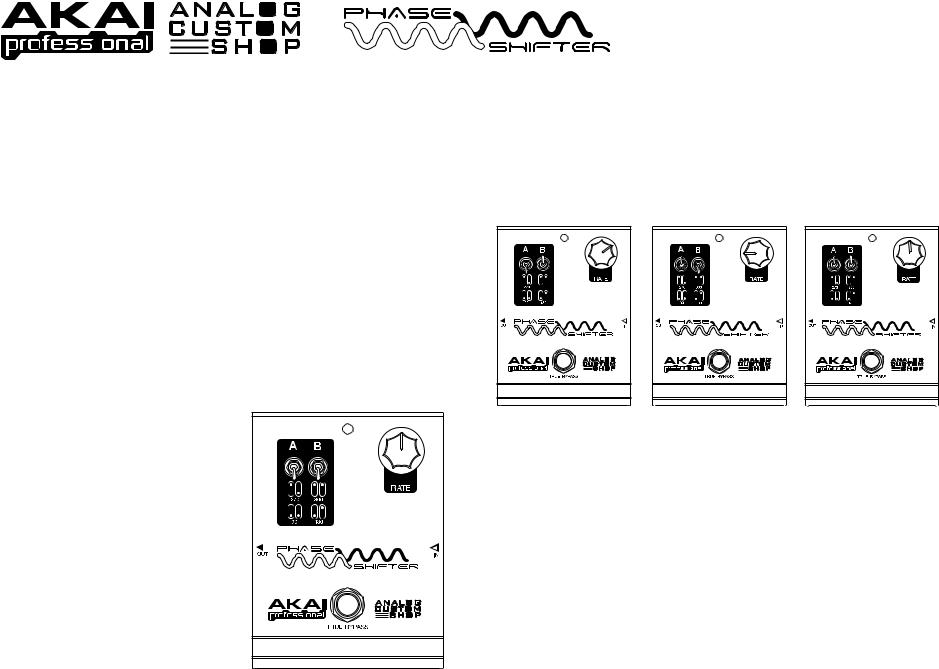Akai Phase Shifter Quick Start Guide [en, es]

Thank you for purchasing the Analog Custom Shop Phase Shifter!
Please read the important notes in this Quickstart Guide to ensure the best possible experience with your new pedal.
A few notes about power:
Battery:
•To install the included 9V battery, remove the battery cover on the bottom panel of the pedal. Snap the terminal connector's onto the battery's terminals. Replace the cover, and you're ready to play!
•When using battery power, disconnect your cable from the pedal's input jack when you are not playing. (The input jack works like an on/off switch for battery power.)
•If you are not going to use your pedal for an extended period, disconnect and remove the battery. Over long periods of time, batteries can sometimes leak, and their acid or other residue can damage the pedal. Damage caused by battery leakage is not covered under warranty.
Power adapter (optional):
•To power the pedal with a power adapter, we recommend purchasing the Akai MP9-P6 (9V DC, 300 mA [200 mA minimum], center-negative).
Description:
A phase shifter is an effect that splits the input signal, adds a slight delay to one signal and recombines them to create a "comb filter." This can create an effect similar to a flanger but with a slightly different sound. The Analog Custom Shop Phase Shifter is a 10-stage phaser, which can result in some deep sounds with deeper, more resonant effects or subtle harmonic sweeps.
The controls:
A/B SWITCHES: These two switches can be set in a total of four combinations, which are shown next to the switches themselves – 90, 180, 270, and 260. These settings indicate the intensity of the phasing. The 90 position creates a subtle phase while the 360 position creates a much more resonant, deep phasing sound.
RATE: Turn this knob to adjust the rate of the effect (how quickly the phasing occurs).
BYPASS SWITCH: Step on this switch to turn the effect on or off. This pedal features a true bypass switch, meaning your signal won't be colored by the pedal's circuitry when the effect is off.
QUICKSTART GUIDE (ENGLISH)
7-51-0349-A
Suggested settings:
Phase Shifter can give your sound a lot of depth and nuance.
To start, we suggest using a light phase setting (Figure 1) by setting the A/B SWITCHES to "90" (both in the "down" position). From there, turn the RATE knob to play with how fast the phase shifter's modulation is. Flip the B SWITCH up to enter the 180 setting, where the phasing should become more intense.
Increase it yet again by setting the A SWITCH up and the B SWITCH down – the 270 setting. Adjust the RATE knob to experiment with the speed of the phasing at these settings. Finally, set both A/B SWITCHES in the "up" position for the most intense phasing.
Here are a few suggestions to get you started:
Figure 2 |
Figure 3 |
Figure 4 |
Notes about signal flow:
Where you place the Phase Shifter in your audio chain will change how it works and influences the sound of your other effects.
Most of the time, it's recommended that the Phase Shifter be placed closer to the end of your effects chain, especially after your distortion, fuzz, filter, and other tone pedals. This allows you to tailor your sound with those pedals first, then allowing that whole sound to be modulated by the phase shifter.
But don't let that stop you from experimenting with its placement in your effects chain. Play around with some new and interesting tones – and find your sound in the process!
Figure 1
www.akaipro.com
